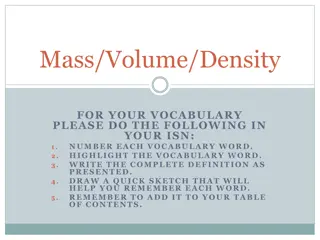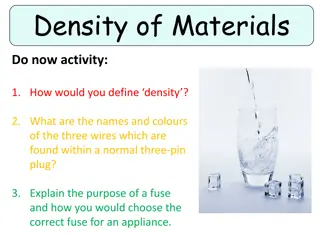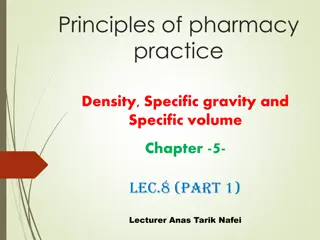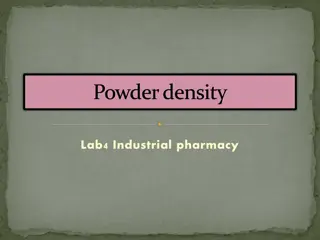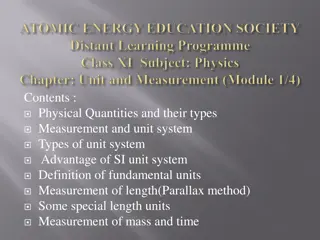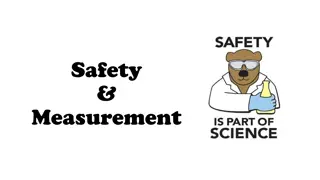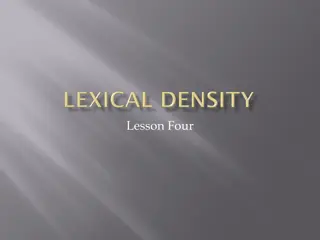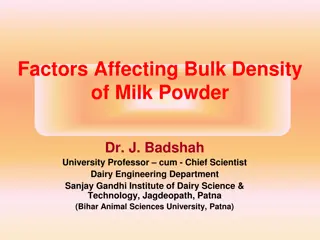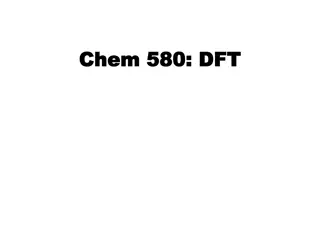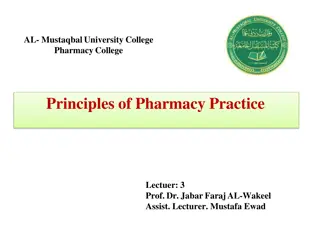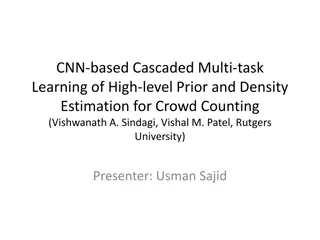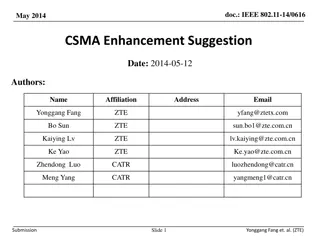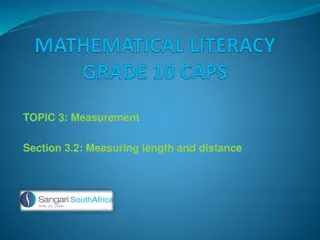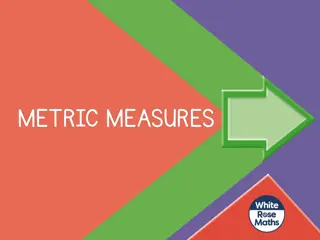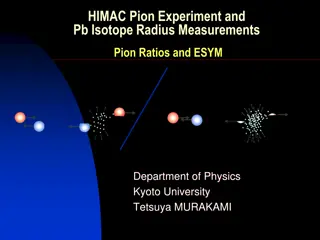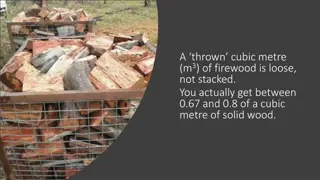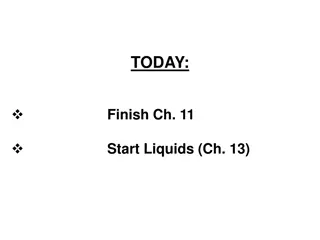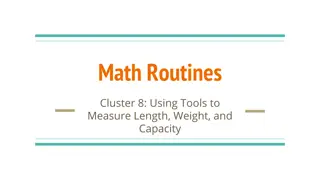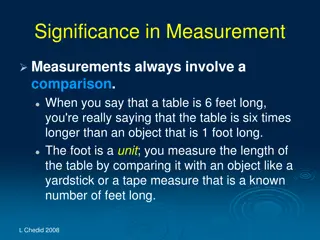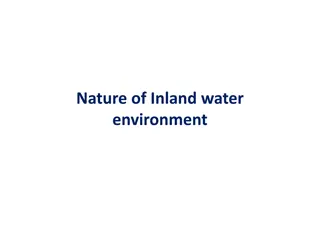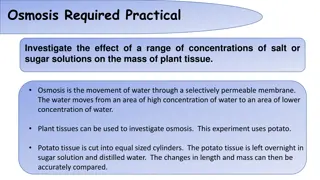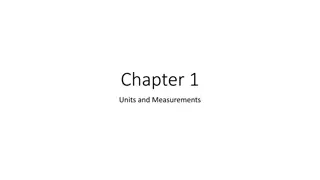Understanding Measurement: Length, Mass, Volume, Density
Explore the fundamental concepts of measurement, including length using metric tools, finding mass with a balance, distinguishing between mass and weight, calculating volume through displacement or dimensions, and understanding density. Discover how to measure and differentiate these properties in solids and liquids. Gain insights into the metric system units, tools, and methods for accurate measurements.
Download Presentation

Please find below an Image/Link to download the presentation.
The content on the website is provided AS IS for your information and personal use only. It may not be sold, licensed, or shared on other websites without obtaining consent from the author. Download presentation by click this link. If you encounter any issues during the download, it is possible that the publisher has removed the file from their server.
E N D
Presentation Transcript
I can measure length using the metric side of the ruler. I can find the mass of an object using a balance. I can know the difference between mass and weight. I can find the volume of an object by using the water displacement method or length x width x height. I can calculate density. I can find relative density by how liquids layer.
Mass, Volume, & Density solid
Length - the distance from end to end of an object Tools: Meter Stick , Metric Ruler Units: Meter (m), Centimeter (cm)
A balance is used to measure mass. The metric system uses grams (g) If you are measuring a liquid, do not forget to subtract the mass of the container.
Mass - the amount of matter in an object Measured with a balance Does not change Units - grams Weight -a measurement of the gravitational force acting on an object Measured with a scale Changes depending on gravity Units - pounds
Volume is the amount of space that an object takes up. Which has more volume; a popcorn kernel or a piece of popped corn?
Volume: is the amount of space that matter takes up Volume can be in the form of a solid, liquid, or gas. There are three different types of volume: 1. Liquid Volume 2. Regular Volume 3. Irregular Volume
A regular shaped solid would be one that you could easily measure the length, width, and height using a ruler. LENGTH X WIDTH X HEIGHT Measures in cm cubed.
Tools: Ruler or Meter Stick Volume = L x W x H 6 cm x 4 cm x 7 cm = 168 cm3 Units: Centimeters Cubed (cm3) 1 cm3 = 1 mL
An irregular shaped solid would be a solid object that could not be easily measured by a ruler. Example: a rock or a cap eraser. When this is the case, you look at water displacement in a graduated cylinder. This is measured in ml.
Tool: Graduated Cylinder Water Displaced Method Units: (cm3) 1. Put a set quantity of water into the graduated cylinder and note the starting volume 2. Place the irregularly shaped object into the graduated cylinder 3. The water will rise - record the new volume 4. The difference between the new and starting volumes is the volume of the irregular object
To find the volume of a liquid, you simply pour it into a beaker or a graduated cylinder and read it in ml.
Tool: Graduated Cylinder Units: milliliters (mL) liters (L) What is a meniscus? A meniscus is the curved surface of a liquid
1 kg of rocks 1 kg of feathers
Density is the amount of matter in a given space. Density is a physical property because it can be observed/measured without changing the object. Density can be used to identify substances because no two substances have the same density. Density does not depend on size or shape - the density of a single substance will remain the same no matter the sample s size or shape.
DENSITY Density is a measure of how tightly packed and how heavy the molecules are in an object. Density is the amount of matter within a certain volume (or space).
1- Find the mass of the object balance. 2- Find the volume of the object Is it a regular shaped object, an irregular shaped object, or a liquid? 3- Divide Density = Mass Volume
Density is the amount of mass in a given space (volume). The formula for density is... Mass Density = --------------- Volume Units for density Solid = g/cm3 Liquid = g/mL
m = mass v = volume D = density The Density T-Triangle can be used to write 3 different formulas. Formula for density: D = m/v Formula for mass: m = D x v Formula for volume: v = M/D m D v
To find density: 1) Find the mass of the object 2) Find the volume of the object 3) Divide : Density = Mass - Volume Ex. If the mass of an object is 35 grams and it takes up 7 cm3 of space, calculate the density Set up your density problems like this: Given: Mass = 35 grams cm3) Volume = 7 cm3 Unknown: Density (g/cm3 Solution: D = 35g/7 cm3 Formula: D = M / V D = 5 g/cm3
Frank has a paper clip. It has a mass of 9g. Paper clip was lowered into a graduated cylinder holding a volume of water equal to 2.0 mL.The height of the water rose to 5mL. What is its density? Given/Unk nown D = m = v = 3cm3 ? =? ? Work ? 5 2 = 3ml = 3cm3 9g 9g = 3g/cm3 D = 3??3
Frank also has an book. It has a mass of 12g. The book has a length of 3cm, and width of 2cm, and a height of 2cm. What is its density? Given/Unk nown D = m = v = 12cm3 Work ? 3cm(2cm)(2cm)= 12cm3 12g 12g 12??3 ? =? = 1g/cm3 D = ?
A book has a density of 10 g/cm3. What would be the mass of the book if the volume is 5cm3. Given/Unk nown D = m = v = 5cm3 Work 10g/cm3 ? ? =? = 50g ? = 10?/??3(5cm3) M =d(v) ?
Ways to Affect Density Increase the mass Decrease the mass Which container has more density? increase density decrease in density A B
Ways to Affect Density Increase the volume Decrease the volume Which container has more density? decrease density increase density A B
Keep the same mass AND decrease the volume Keep the same volume AND increase the mass
If you pour together liquids that dont mix and have different densities, they will form liquid layers. The liquid with the highest density will be on the bottom. The liquid with the lowest density will be on the top. Objects or substances with MORE density will sink below objects or substances with LESS density Which do you think is MORE dense, Water or Oil???
The oil is less dense than the water, so its on top. The superball is less dense than water, but more dense than oil, so it sinks to the bottom of the oil layer, yet floats on the top of the water layer.
If you have 2 or more substances, the MORE dense substance will be on bottom The LESS dense substance will be on top
Check out this picture. Which layer has the highest density? Which layer has the lowest density? Imagine that the liquids have the following densities: 10g/cm3. 3g/cm3. 6g/cm3. Which number would go with which layer? 3 g/cm3 5 g/cm3 5g/cm3. 6 g/cm3 10 g/cm3
The Density of Water is 1 g/mL An object/material will sink in water if it has a density greater than 1 g/mL. An object/material will float on water if has a density less than 1 g/mL. Practice Problem: Will a material with a mass of 110 g and a volume of 312 cm^3 float on or sink in water? Claim: Evidence: Reasoning:
What is the formula for density? What happens if you pour together liquids that have different densities? Will the liquid on the top have the highest or lowest density? Will the liquid on the bottom have the highest or lowest density?
Jake has a book, a ruler, and a balance. How can Jake find the density of the book with the tools he has?




